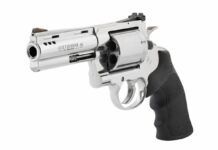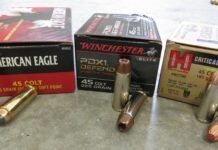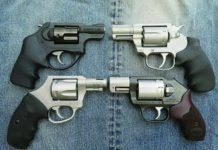Faced with deciding which is the best handgun caliber or action design for self-defense, the traditional answer was once to carry the biggest gun you could handle. Then, in the age of concealed-carry permits, the answer increasingly has become carry the biggest gun you can conceal. Now enter downsizing. The conventional carry wisdom now reads the best gun is the one you have with you.
However, to take advantage of the latest philosophy, your carry gun needs to be wearable, and bearable at that. Reducing the weight of guns to make continuous carry livable is the reason ultra-light titanium has been adapted to handgun construction. Wheel guns built wholly or in part with titanium are now available from both Taurus International and Smith & Wesson. Going back just a few months, the first titanium revolvers were chambered for .38 Special +P only. But Smith & Wesson now offers a .44 Special, as does Taurus, and the latter company will shortly be shipping all-titanium revolvers in .41 Magnum and .45 Long Colt as well.
But, we wondered: When will the power curve make shooting very light guns unbearable? To find out, Gun Tests secured not only the latest titanium guns, but also comparable models in steel and alloy as well. Comparing these frame materials, we wanted to learn what titanium’s tradeoffs are. Are they strong enough? What about the added recoil? Will the government require these apparition-weight products to come not only with a safety lock but a PAST shooting glove as well? Anticipating a rocky ride, we began shooting the heaviest gun in the test and moved toward the lightest one, adding glove, wrist-wrap and Ibuprofen as we went. The guns were the 36-ounce Smith & Wesson 696 stainless-steel five-shooter, $525; Taurus’s 445, a 29-ounce five-shot stainless steel gun; the 22-ounce Taurus 445 Ultra-Lite alloy five shooter; the Taurus Total Titanium five-shot 445TBC, 20.5 ounces; and Smith & Wesson’s 296 Centennial five-shot L-frame, 19.5 ounces.
Range Session
It’s always hard to look forward to repeat firing of super-light carry guns. For help in this regard we enlisted the services of a PAST shooting glove. We’d like to thank this product for making this test possible. It’s ironic that the strongest gun wilted, and none of the super-lights complained once. The comparatively big S&W 696 bowed out after only two groups of accuracy rounds were fired from a sandbag rest at 15 yards. All shots passed through an Oehler Chronograph with proof channel and printer, so velocity data is taken from an average of 25 rounds per gun per ammo. (Five five-shot groups).
Shooting the guns, we didn’t use the glove while firing the 696. The stainless Taurus 445 wasn’t really a problem either, but we elected to wear the glove and thereafter used an elastic wrist wrap as well. Standing at 10 yards for the rapid-fire drill was easier to take because unlike firing from the bench, the recoil was not wholly captured by the wrist joint. Of the super-light guns we’ve shot recently, only the Taurus 85ULTI ported .38 Special has been completely comfortable to shoot. Some of the guns had trouble with point of aim even at 15 yards. Taurus’s blue titanium gun (445TBC) was off as much as 6 inches low with 180-grain ammo. The Taurus UL was low by 4 inches with this same ammo and was 6 inches low even with the 210-grain lead bullet from Black Hills. Too bad, since the groups with Black Hills ammo varied only as much as 1.8 to 2.2 inches. Taurus’s all-steel 445 fired this same ammo to point of aim and was the best of show with groups as little as 1.1 to 2.0 inches. The S&W titanium .44 Special was limited to bullets under 200 grains and liked the PMC 180-grain JHP, delivering all groups under 3 inches.
Here’s how the guns performed in more detail.
Smith & Wesson 696
Our recommendation: Pass. This $525 full-size L-frame stainless-steel revolver seems like a stranger next to the L-frame Centennial. Adjustable sights, target hammer, full-lug barrel, but only five shots of .44 Special in a heavy steel frame. It was the only gun to break during the test.
Why is this gun even in the test? Let’s call it a control, a steel five-shooter for which nearly every serious shooter has a frame of reference. Smith went about shrinking the Model 629 .44 Magnum and its long-lost brother the 624 from an N frame to the mid-sized L. The result: It’s too heavy to carry, but it may fit into the glove box. But then again, it’s only a five-shooter.
With all-steel construction, a fully shrouded ejector rod, and the thickest forcing cone of any gun in this test (just shy of 0.040 inch) what could go wrong? How about a double-action trigger that sometimes cycles the cylinder but will not pull back the hammer? The first sign of a problem was a loss of trigger return. Attempts at firing single action resulted in getting the hammer to drop but not with sufficient force to detonate the rounds. It’s ironic that such a heavily built gun wouldn’t tolerate more than 10 shots of PMC’s 180-grain jacketed hollow point. Other quality points varied as well. The seam at the side plate is nearly invisible, but there is a noticeable gap between the barrel shroud and the frame. The crane lock-up has an uneasy feeling, and we judged the crane-to-frame gap to be excessive. The front sight is on its way to letting go, turning upward on its pin. The ramped front sight has serrations interrupted by a plastic orange insert. We could never figure out the justification for this insert. Its smooth finish just creates glare and hinders the sight picture, especially from a sandbag rest. Without clear definition of the front sight, accuracy is penalized. Ergonomically, the gun’s round-butt design covered with an Uncle Mike’s grip proved very comfortable. For the record this gun produced two five-shot groups of Winchester’s 246-grain LRN measuring 2.0 and 2.1 inches with a very good point-of-aim before its demise.
Taurus 445
Our recommendation: Great gun. Built on Taurus’s smallest frame, the 445’s all-steel construction lends welcome heft to create a sensible package of dynamite.
In our opinion the all-steel version of the Taurus 445 series makes the most sense. Yes, it’s heavier than the alloy and titanium guns, but its compact design balances the gun well, making for a neat center of gravity that should sit well at the belt line. There’s enough grip and enough backstrap for most sizes of hands. The barrel on this model is not compensated, but the efficient grip and well distributed weight do a nice job of killing recoil. Add to this a front sight that is tall with serrations that diffuse enough light for accurate use despite being satin stainless, and you’ve got a revolver that is fun to shoot fast. The extractor is shrouded and all edges are nicely beveled. While a bobbed hammer would be better, the supplied tang does not protrude beyond the contour of the backstrap and sighting notch.
Taurus’s patented locking system is included, activated by one of two supplied keys. The finish on the gun is polished and durable. One argument against this type of finish is its flashiness, based on the assumption that a sudden reflection will make the presence of a gun known prematurely. The other side of the argument is this finish will hold up better when exposed to body acids and sweat, an adversary more prevalent than the criminal element. Our only complaint was one common to the older Taurus guns. That is, when the gun heats up, the trigger suddenly becomes hard to pull. One answer is to enlarge the cylinder gap so that expansion from heat avoids dragging the cylinder face on the forcing cone. We measured the cylinder gap on this sample to be an outrageously tight 0.0015 inch. Somebody in Brazil must have thought this revolver was built for Bianchi Cup competition. The other answer, one Taurus has found with its alloy guns, is to use a different quality material that resists expansion at higher temperatures. Yet another answer might be to make the cylinder and the frame of less-alike steels, assuming this malady is a case of galling. Otherwise, the steel 445 is a happy, willing shooter that we felt displayed the best combination of power and size of all the .44s in this test.
Taurus 445 Ultra-Lite
Our recommendation: Worth buying if the sights will shoot to point of aim. The Ultra-Lite series is a good balance of weight and controllability in a slightly bigger package than the company’s Model 85s.
Snubbies used to be simple. If a bobbed or concealed hammer was not available, you simply lopped off the offending tang and voil, a custom concealment gun. Here is a list of features crammed into the 445UL: Brushed alloy frame, satin finished barrel shroud and cylinder, shrouded ejector, six-port compensator, black anodized serrated front sight, crane ball-detent lock-up, the Taurus security system, and ribbed neoprene grips. What does all this add up to? Sub 3-inch groups (on average) from a sandbag rest at 15 yards for all ammunition tested. What’s the catch? A poor point of aim. The results on target suffered from being low left for the most part.
While the groups were consistent, the elevation changed little from the lightest bullets at 180 grains to the heaviest at 246 grains. Switching hands to address the windage problem helped little, leaving us with the conclusion that the answer lay with misalignment of the barrel or improper orientation of the front to rear sight. The 445UL uses a combination of a solid, not pinned, front sight and a notch in the top strap for the rear sight. Sometimes windage can be adjusted by opening this notch, and elevation may be addressed by filing down the front blade. Building up the rear sight a la Novak might be the best place to start because the front blade is not removable, and it is mounted between the ports with little room to spare.
All the guns in this report could use some action work. So, the potential is there for a reasonably accurate, reliable carry gun. Its main advantage over the stainless 445 is the lack of galling or cylinder drag, and it is a better fit for larger hands. The jury is still out on the squishy grips. The compensation system works well enough that we’d prefer the more stable grip that harder rubber would offer. The 445UL is lighter than a straight stainless gun, but you won’t need the Ace bandage or PAST glove for rapid-fire training sessions. We’d sure like to know if our hunch about modifying the sights would cure the point of aim problem.
Taurus Total Titanium Model 445TBC
Our recommendation: The light 445TBC’s felt recoil was less because of porting and a high hand position. Worth a look.
Like the 445UL this Taurus also displayed problems with point of aim. But we found that unlike the Ultra-Lite, this model responded positively, perhaps to the difference in its structural mass, to bullet weight. While the lighter 180-grain bullets struck low, the heavier bullets produced the intended elevation at point-of-aim. The 200-grain Winchester Silvertip Hollow Point produced the best accuracy, but the heavier bullets, such as the Winchester 246-grain LRN, produced the best point of aim. Perhaps a heavier jacketed bullet is the answer to both problems.
Unfortunately, our titanium 445 also locked up when heated. But again, the cylinder-to-forcing-cone gap was inordinately small, 0.002 inch in fact. Smith & Wesson’s 296 showed a gap of 0.005 inches.
There is a marked difference in the actions of the alloy UL and the titanium ULTi. This 445TBC all-titanium revolver shares the trigger feel of older-style Taurus guns; that is, it has a short action with a stacking feel, then a sudden acceleration and release. This is fine for rapid fire, but not as precise as the trigger that appears on more recent models. The only difference we see between this gun and its predecessors is the titanium construction. To begin with, the Taurus action is based on a coiled mainspring in a configuration based on Smith & Wesson’s J-frame series. Lately, such models as the UL series reflect a change in the modulation of the mainspring pressure to make trigger pull more even. That being said the Taurus 445TBC succeeds in its design purpose as an extremely lightweight package for close encounters of the unkind kind.
Smith & Wesson 296 Centennial
Our recommendation: No one ever thought the Centennial series would come to this: a hammerless humpbacked L-frame complete with accommodation for a lanyard. But it works!
The Smith & Wesson 296, despite weighing in slightly over the nothing mark, produced power factors with the test ammunition ranging from 139 to 149. Another time around with the adhesive tape please. Power factor is a good indication of brute force, a term we like better than delivery of, or transference of energy. It is calculated by multiplying the weight of the bullet by its velocity divided by 1000. The all steel Taurus 445 developed a power factor of 150 with the Winchester 246-grain LRN. The 296 rang in with its highest power factor (149) by driving the PMC 180-grain JHPs 830 fps. Thank you PACT for the glove. We would have loved to fire the 246-grainers in the Smith gun, but it says right on the barrel, MAX BULLET 2OO GRAINS. What S&W is afraid of is that the 296 will become an expensive bullet-puller on recoil. The 296 is so light, when the recoil moves the gun rearward, the only thing left behind would be the big, heavy, soft, lead bullet standing still, giving up its crimp and finding itself sticking out the front of its chamber, impeding further rotation of the cylinder. Taurus claims to have overcome this problem by recoil reduction via compensation.
When it comes to concealment, nothing is smoother than the Centennial series. It is virtually snag free. The 296 is not quite light enough to hang around your neck, unless you’re Mr. T. The Uncle Mike’s boot grip with open back strap sits ergonomically correct in the hand, but the cylinder and bore line is way above it, adding to recoil. But, then again, even though the bore line is nearly 3 inches above the heart of the trigger, top heavy doesn’t really count when the gun isn’t that heavy to begin with.
The 296 is sculpted in two shades of gray plus a black front sight-blade (serrated and pinned), offset by a black rubber grip, and a charcoal-shaded cylinder and internal retaining pins. The front sight is easy to find despite the rear notch being nearly invisible from anywhere but from behind the grip. The crane is devoid of a detent lockup, but fits tightly into the frame. We found the trigger stacked a little bit before let-off, but accuracy was very good. The best groups were produced with the most powerful ammo, the 180-grain JHP from PMC. However, this is not a gun you’ll want to spend a lot of time practicing with due to its recoil.
Gun Tests Recommends
To sum up this exercise in steel, aluminum, titanium, and lead, below we say buy, or good-bye, to our little round friends:
Taurus Stainless Steel 445, $351. Buy. The size and weight of this package match up well to the .44 Special cartridge, in our view. We feel the heat-driven lockup problem can be addressed inexpensively.
Smith & Wesson 296, $625. Buy. If you are love with the .44 Special cartridge, this clunky but light revolver is good for everyday concealment (especially off the body, like in a briefcase, purse, or pouch).
Taurus Total Titanium 445TBC, $599. Conditional buy. We feel the lockup problem can be addressed in a steel gun, but we just don’t know enough about titanium yet to be confident about the cost or effectiveness of increasing the cylinder gap. If this modification could be made, we feel it is adequate as a fast-pull close-range weapon.
Taurus 445 UL Ported, $599. Conditional buy. There is probably a bullet that matches up well enough to make this gun shoot closer to point of aim. It’s loaded with features, but needs adjustment.
Smith & Wesson Stainless Steel 696, $525. Goodbye. Besides the fact that it broke, we don’t see the need to weigh ourselves down for the sake of only five rounds of .44 Special. Smaller, more compact five-shooters chambered for .357 Magnum pack more punch.




























